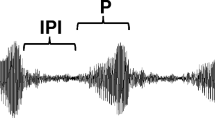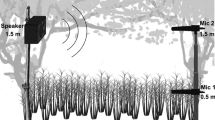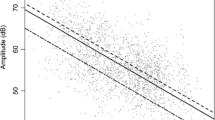Abstract
Many animals produce long-distance acoustic signals to mediate a variety of social interactions, and the efficacy of transmission depends in part on environmental attenuation. Vocalizing from positions that optimize transmission is one key solution to minimizing attenuation, though few studies assess the magnitude of this effect in relation to receiver position. In this study, we assessed how transmission of high-frequency vocalizations produced by pinyon mice (Peromyscus truei) varied based on the position of senders and receivers. Pinyon mice are semi-arboreal rodents that produce sustained vocalizations to advertise to conspecifics. Synthesized signals derived from a population-sample-average of fundamental frequency, duration, and amplitude were broadcast and recorded at different heights (0, 1, and 2 m) and distances (1, 2, 4, and 8 m) in a full factorial design to mimic hypothetical senders and receivers. We also measured receiver hearing sensitivity using auditory brainstem responses (ABR) to quantify the audible distance (active space) of vocalizations at different heights. Vocalizations showed less attenuation when emitted and received from an elevation compared to the ground if the signal was received at least 4 m from the sender. Vocalizations emitted from a 1 m height had an approximately 3 times greater audible distance compared to the ground. Additionally, less attenuation occurred when both senders and receivers were elevated at the same height and when receivers were elevated, regardless of sender height. Our results highlight the importance of considering receiver position in animal communication, especially when senders produce highly directional signals.
Significance statement
Vocalizing animals often position themselves in locations that maximize sound transmission. However, the magnitude of this effect is not often quantified, especially in relation to the position of intended receivers. In this study, we combined acoustic recording, hearing experiments, and modelling of sound attenuation to quantify how sending and receiving vocalizations from trees impacts sound transmission in a semi-arboreal mouse. We found that vocalizations produced from 1 m above the ground could be heard by receivers at 3 times the distance compared to ground level. We also found that no matter the sender position, receivers benefitted from being at elevated positions. Finally, we found that the least attenuation occurred when senders and receivers were elevated at the same height. Our results highlight the importance of considering receiver position in animal communication, especially when senders produce highly directional signals.



Similar content being viewed by others
Data availability
All datasets generated and analyzed during this study are included in the supplementary information files of this published article.
References
Arak A, Eiriksson T (1992) Choice of singing sites by male bushcrickets (Tettigonia viridissima) in relation to signal propagation. Behav Ecol Sociobiol 30:365–372. https://doi.org/10.1007/BF00176170
Bailey V (1931) Mammals of New Mexico. United States Department of Agriculture, Bureau of Biological Survey, Washington
Barker NKS, Mennill DJ (2009) Song perch height in Rufous-and-White Wrens: Does behaviour enhance effective communication in a tropical forest? Ethology 115:897–904. https://doi.org/10.1111/j.1439-0310.2009.01674.x
Bates D, Mächler M, Bolker B, Walker S (2015) Fitting linear mixed-effects models using lme4. J Stat Softw 67:1–48. https://doi.org/10.18637/jss.v067.i01
Ben-Shachar MS, Lüdecke D, Makowski D (2020) effectsize: Estimation of effect size indices and standardized parameters. J Open Source Softw 5:2815
Blumenrath S, Dabelsteen T (2004) Degradation of Great Tit (Parus Major) song before and after foliation: Implications for vocal communication in a deciduous forest. Behaviour 141:935–958. https://doi.org/10.1163/1568539042360152
Boncoraglio G, Saino N (2007) Habitat structure and the evolution of bird song: A meta-analysis of the evidence for the acoustic adaptation hypothesis. Funct Ecol 21:134–142. https://doi.org/10.1111/j.1365-2435.2006.01207.x
Bradbury JW, Vehrencamp SL (2011) Principles of animal communication, 2nd edn. Sinauer Associates, Sunderland, Massachusetts
Brenowitz EA (1986) Environmental influences on acoustic and electric animal communication. Brain Behav and Evol 28:32–42. https://doi.org/10.1159/000118690
Briggs JR, Kalcounis-Rueppell MC (2011) Similar acoustic structure and behavioural context of vocalizations produced by male and female California mice in the wild. Anim Behav 82:1263–1273. https://doi.org/10.1016/j.anbehav.2011.09.003
Brumm H, Zollinger SA (2011) The evolution of the Lombard effect: 100 years of psychoacoustic research. Behaviour 148:1173–1198. https://doi.org/10.1163/000579511X605759
Camargo NF, Machado LF, Mendonça AF, Vieira EM (2019) Cranial shape predicts arboreal activity of Sigmodontinae rodents. J Zool 308:128–138. https://doi.org/10.1111/jzo.12659
Capshaw G, Vicencio-Jimenez S, Screven LA, Burke K, Weinberg MM, Lauer AM (2022) Physiological evidence for delayed age-related hearing loss in two long-lived rodent species (Peromyscus leucopus and P. californicus). J Assoc Res Otolaryngol 23:617–631. https://doi.org/10.1007/s10162-022-00860-4
Clifford MJ, Cobb NS, Buenemann M (2011) Long-Term Tree Cover Dynamics in a Pinyon-Juniper Woodland: Climate-Change-Type Drought Resets Successional Clock. Ecosyst 14:949–962. https://doi.org/10.1007/s10021-011-9458-2
Dabelsteen T, Pedersen SB, Larsen ON (1993) Habitat-induced degradation of sound signals: quantifying the effects of communication sounds and bird location on blur ratio, excess attenuation and signal-to- noise ratio. J Acoust Soc Am 93:2206–2220. https://doi.org/10.1121/1.406682
Dent ML, Screven LA, Kobrina A (2018) Hearing in rodents. In: Dent M, Fay R, Popper A (eds) Rodent Bioacoustics. Springer, Cham, pp 71–105. https://doi.org/10.1007/978-3-319-92495-3_4
Dice LR, Barto E (1952) Ability of mice of the genus Peromyscus to hear ultrasonic sounds. Science 116:110–111. https://doi.org/10.1126/science.116.3005.110
Emlen T, Oring LW (1977) Ecology, sexual selection, and the evolution of mating systems. Science 197:215–223. https://doi.org/10.1126/science.327542
Ey E, Fischer J (2009) The “acoustic adaptation hypothesis”—a review of the evidence from birds, anurans and mammals. Bioacoustics 19:21–48. https://doi.org/10.1080/09524622.2009.9753613
Fernández-Vargas M, Riede T, Pasch B (2022) Mechanisms and constraints underlying acoustic variation in rodents. Anim Behav 184:135–147. https://doi.org/10.1016/j.anbehav.2021.07.011
Goutte S, Dubois A, Howard SD, Márquez R, Rowley JJL, Dehling JM, Grandcolas P, Xiong RC, Legendre F (2018) How the environment shapes animal signals: a test of the acoustic adaptation hypothesis in frogs. J Evol Biol 31:148–158. https://doi.org/10.1111/jeb.13210
Green DM, Scolman T, Pasch B (2019) A broad filter between call frequency and peripheral auditory sensitivity in northern grasshopper mice (Onychomys leucogaster). J Comp Physiol A 205:481–489. https://doi.org/10.1007/s00359-019-01338-0
Greene C (2021) MATLAB Central File Exchange: Sound Pressure Level Calculator. MathWorks. https://www.mathworks.com/matlabcentral/fileexchange/35876-sound-pressure-level-calculator
Hager ER, Hoekstra HE (2021) Tail length evolution in deer mice: Linking morphology, behavior, and function. Integr Comp Biol 61:385–397. https://doi.org/10.1093/icb/icab030
Hall LS, Morrison ML (1997) Den and relocation site characteristics and home ranges of Peromyscus truei in the White Mountains of California. Great Basin Nat 57:124–130
Harney BA, Dueser RD (1987) Vertical stratification of activity of two Peromyscus species: an experimental analysis. Ecology 68:1084–1091. https://doi.org/10.2307/1938380
Hayes AR, Huntly NJ (2005) Effects of wind on the behavior and call transmission of pikas (Ochotona princeps). J Mammal 86:974–981. https://doi.org/10.1644/1545-1542(2005)86[974:EOWOTB]2.0.CO;2
Heffner HE, Heffner RS (2003) Audition. In: Davis SF (ed) Handbook of research methods in experimental psychology. Blackwell, Boston, MA, pp 413–440. https://doi.org/10.1002/9780470756973.ch19
Heffner RS, Koay G, Heffner HE (2001) Audiograms of five species of rodents: implications for the evolution of hearing and the perception of pitch. Hear Res 157:138–152. https://doi.org/10.1016/S0378-5955(01)00298-2
Hoffmeister DF (1951) A taxonomic and evolutionary study of the piñon mouse, Peromyscus truei. University of Illinois Press, Urbana. https://doi.org/10.5962/bhl.title.50289
Hoffmeister DF (1981) Peromyscus truei. Mamm Species 161:1–5
Holbrook S (1978) Habitat relationships and coexistence of four sympatric species of Peromyscus in northwestern New Mexico. J Mammal 59:18–26
Holland J, Dabelsteen T, Pedersen SB, Larsen ON (1998) Degradation of song in the wren Troglodytes troglodytes: Implications for information transfer and ranging. J Acoust Soc Am 103:2154–2166. https://doi.org/10.1121/1.421361
Horner E (1954) Arboreal adaptations of Peromyscus, with special reference to use of the tail. University of Michigan, Ann Arbor, MI
Huihua Z, Shuyi Z, Mingxue Z, Jiang Z (2003) Correlations between call frequency and ear length in bats belonging to the families Rhinolophidae and Hipposideridae. J Zool 259:189–195. https://doi.org/10.1017/S0952836902003199
Jakobsen L, Brinkløv S, Surlykke A (2013) Intensity and directionality of bat echolocation signals. Front Physiol 4:89. https://doi.org/10.3389/fphys.2013.00089
Kalcounis-Rueppell MC, Spoon TR (2009) Peromyscus boylii. Mamm Species 838:1–14
Kalcounis-Rueppell MC, Metheny JD, Vonhof MJ (2006) Production of ultrasonic vocalizations by Peromyscus mice in the wild. Front Zool 3:3. https://doi.org/10.1186/1742-9994-3-3
Kalcounis-Rueppell MC, Petric R, Marler CA (2018) The bold, silent type: predictors of ultrasonic vocalizations in the genus Peromyscus. Front Ecol Evol 6:198. https://doi.org/10.3389/fevo.2018.00198
Kalcounis-Rueppell MC, Pultorak JD, Blake BH, Marler CA (2018) Ultrasonic vocalizations of young mice in the genus Peromyscus. Handb Behav Neurosci 25:149–156. https://doi.org/10.1016/B978-0-12-809600-0.00014-7
Kalcounis-Rueppell MC, Pultorak JD, Marler CA (2018) Ultrasonic vocalizations of mice in the genus Peromyscus. Handb Behav Neurosci 25:227–235. https://doi.org/10.1016/B978-0-12-809600-0.00014-7
Kalcounis-Rüppell MC, Millar JS (2002) Partitioning of space, food, and time by syntopic Peromyscus boylii and P. californicus. J Mammal 83:614–625. https://doi.org/10.1644/15451542(2002)083%3c0614:POSFAT%3e2.0.CO;2
Kingsley EP, Kozak KM, Pfeifer SP, Yang DS, Hoekstra HE (2017) The ultimate and proximate mechanisms driving the evolution of long tails in forest deer mice. Evol 71:261–273. https://doi.org/10.1111/evo.13150
Kobrina A, Hidau MK, Riede T, Guthrie O, Pasch B (2021) Age-related and noise-induced hearing loss alters grasshopper mouse (Onychomys) vocalizations. Hear Res 404:108210. https://doi.org/10.1016/j.heares.2021.108210
Kobrina A, Letowt ME, Pasch B (2022) The influence of social context on pinyon mouse (Peromyscus truei) vocalizations. J Mammal 103:275–286. https://doi.org/10.1093/jmammal/gyab127
Kobrina A, Letowt ME, Pasch B (2022) Vocal repertoire and auditory sensitivity of white-throated woodrats (Neotoma albigula). J Comp Psychol 137:116–128. https://doi.org/10.1037/com0000330
Kroodsma DE, Byers BE, Goodale E, Johnson S, Liu WC (2001) Pseudoreplication in playback experiments, revisited a decade later. Anim Behav 61:1029–1033. https://doi.org/10.1006/anbe.2000.1676
Leiser-Miller LB, Santana SE (2020) Morphological diversity in the sensory system of phyllostomid bats: Implications for acoustic and dietary ecology. Funct Ecol 34:1416–1427. https://doi.org/10.1111/1365-2435.13561
Lemen C (1980) Relationship between relative brain size and climbing ability in Peromyscus. J Mammal 61:360–364. https://doi.org/10.2307/1380068
Mace GM, Eisenberg JF (1982) Competition, niche specialization and the evolution of brain size in the genus Peromyscus. Biol J Linn Soc 17:243–257. https://doi.org/10.1111/j.1095-8312.1982.tb02019.x
Marten K, Marler P (1977) Sound transmission and its significance for animal vocalization. Behav Ecol Sociobiol 2:271–290. https://doi.org/10.1007/BF00299740
Mathevon N, Dabelsteen T, Blumenrath SH (2005) Are high perches in the blackcap Sylvia atricapilla song or listening posts? A sound transmission study. J Acoust Soc Am 117:442–449. https://doi.org/10.1121/1.1828805
McGregor PK, Catchpole CK, Dabelsteen T et al (1992) Playback and studies of animal communication. Springer, Boston. https://doi.org/10.1007/978-1-4757-6203-7_1
Meserve PL (1977) Three-dimensional home ranges of cricetid rodents. J Mammal 58:549–558. https://doi.org/10.2307/1380003
Metzner W, Schuller G (2010) Vocal control in echolocating bats. Handb Behav Neurosci 19:403–415. https://doi.org/10.1016/B978-0-12-374593-4.00037-1
Müller R, Gupta AK, Zhu H, Pannala M, Gillani US, Fu Y, Caspers P, Buck JR (2017) Dynamic substrate for the encoding sensory information in bat biosonar. Phys Rev Lett 118:158102. https://doi.org/10.1103/PhysRevLett.118.158102
Navarro D (2013) Learning statistics with R. Lulu Press Inc, Morrisville, North Carolina. https://learningstatisticswithr.com
Obrist MK, Fenton MB, Eger JL, Schlegel PA (1993) What ears do for bats: a comparative study of pinna sound pressure transformation in Chiroptera. J Exp Biol 180:119–152. https://doi.org/10.1242/jeb.180.1.119
Petric R, Kalcounis-Rüppell MC (2013) Female and male adult brush mice (Peromyscus boylii) use ultrasonic vocalizations in the wild. Behaviour 150:1747–1766. https://doi.org/10.1163/1568539X-00003118
R Core Team (2017) R: a language and environment for statistical computing. R Foundation for Statistical Computing, Vienna, Austria. http://www.R-project.org
Ralls K (1967) Auditory sensitivity in mice: Peromyscus and Mus musculus. Anim Behav 15:123–128. https://doi.org/10.1016/S0003-3472(67)80022-8
Redmond M, Forcella F, Barger N (2012) Declines in pinyon pine cone production associated with regional warming. Ecosphere 3:120. https://doi.org/10.1890/ES12-00306.1
Ribble DO, Samson FB (1987) Microhabitat associations of small mammals in southeastern Colorado, with special emphasis on Peromyscus (Rodentia). Southwest Nat 32:291–303. https://doi.org/10.2307/3671446
Ribble DO, Stanley S (1998) Home ranges and social organization of syntopic Peromyscus boylii and P. truei. J Mammal 79:932–941. https://doi.org/10.2307/1383101
Richards DG, Wiley RH (1980) Reverberations and amplitude fluctuations in the propagation of sound in a forest: implications for animal communication. Am Nat 115:381–399. https://doi.org/10.1086/283568
Rieger NS, Marler CA (2018) The function of ultrasonic vocalizations during territorial defence by pair-bonded male and female California mice. Anim Behav 135:97–108. https://doi.org/10.1016/j.anbehav.2017.11.008
Riondato I, Gamba M, Tan CL, Niu K, Narins PM, Yang Y, Giacoma C (2021) Allometric escape and acoustic signal features facilitate high-frequency communication in an endemic Chinese primate. J Comp Physiol A 207:327–336. https://doi.org/10.1007/s00359-021-01465-7
Römer H (2020) Insect acoustic communication: The role of transmission channel and the sensory system and brain of receivers. Funct Ecol 34:310–321. https://doi.org/10.1111/1365-2435.13321
Römer H, Lewald J (1992) High-frequency sound transmission in natural habitats: implications for the evolution of insect acoustic communication. Behav Ecol Sociobiol 29:437–444. https://doi.org/10.1007/BF00170174
Ryan MJ, Kime NM (2003) Selection on long-distance acoustic signals. In: Simmons AM, Fay RR, Popper AN (eds) Acoustic Communication. Springer, New York, pp 225–274
Schwartz JJ, Hunce R, Lentine B, Powers K (2015) Calling site choice and its impact on call degradation and call attractiveness in the gray treefrog, Hyla versicolor. Behav Ecol Sociobiol 70:1–19. https://doi.org/10.1007/s00265-015-2016-8
Sikes RS (2016) Guidelines of the American Society of Mammalogists for the use of wild mammals in research and education. J Mammal 97:663–688. https://doi.org/10.1093/jmammal/gyw078
Smartt RA (1978) A comparison of ecological and morphological overlap in a Peromyscus community. Ecology 59:216–220. https://doi.org/10.2307/1936365
Smartt RA, Lemen C (1980) Intrapopulational morphological variation as a predictor of feeding behavior in deermice. Am Nat 116:891–894
Srivathsa A, Tietje W, Rolland V, Polyakov A, Oli MK (2019) Climatic drivers of pinyon mouse Peromyscus truei population dynamics in a resource-restricted environment. Popul Ecol 61:122–131. https://doi.org/10.1002/1438-390X.1006
Stah CD (1980) Vertical nesting distribution of two species of Peromyscus under experimental conditions. J Mammal 61:141–143
Sueur J, Aubin T, Simonis C (2008) Seewave, a free modular tool for sound analysis and synthesis. Bioacoustics 18:213–226. https://doi.org/10.1080/09524622.2008.9753600
Timonin M, Kalcounis-Rueppell M, Marler CA (2018) Testosterone pulses at the nest site modify ultrasonic vocalization types in a monogamous and territorial mouse. Ethology 124:804–815. https://doi.org/10.1111/eth.12812
Waser PM, Brown CH (1986) Habitat acoustics and primate communication. Am J Primatol 10:135–154. https://doi.org/10.1002/ajp.1350100205
Waser PM, Waser MS (1977) Experimental studies of primate vocalization: Specializations for long-distance propagation. Z Tierpsychol 43:239–263. https://doi.org/10.1111/j.1439-0310.1977.tb00073.x
Whipple AV, Cobb NS, Gehring CA, Mopper S, Flores-Rentería L, Whitham TG (2019) Long-term studies reveal differential responses to climate change for trees under soil- or herbivore-related stress. Front Plant Sci 10:132. https://doi.org/10.3389/fpls.2019.00132
Wiley RH, Richards DG (1978) Physical constraints on acoustic communication in the atmosphere: Implications for the evolution of animal vocalizations. Behav Ecol Sociobiol 3:69–94. https://doi.org/10.1007/BF00300047
Yovel Y, Falk B, Moss CF, Ulanovsky N (2011) Active control of acoustic field-of-view in a biosonar system. PLoS Biol 9:e1001150. https://doi.org/10.1371/journal.pbio.1001150
Acknowledgements
We thank E. Roden and D. Hendershott for assistance with trapping and recording mice. We thank two anonymous reviewers for their insightful comments that greatly improved the manuscript.
Funding
The study was funded by the American Society of Mammalogists Grants-in-Aid (RB), a Jean Schuler Research Mini-Grant from Northern Arizona University (RB), and the National Science Foundation IOS # 1755429 (BP).
Author information
Authors and Affiliations
Contributions
RB and BP conceived the study, obtained the funding, and wrote the initial draft of the manuscript. RB, BP, and AK conducted the fieldwork. AK conducted the hearing experiments. SMM and all authors analyzed the data, and revised, edited, and approved the final version of the manuscript.
Corresponding author
Ethics declarations
Ethics approval
All procedures were approved by Northern Arizona University’s Institutional Animal Care and Use Committee (19–006). Animals were captured with permits from the Arizona Game and Fish Department (SP403209). All research followed the guidelines for ethical treatment of animals established by the American Society of Mammalogists (Sikes 2016).
Competing interests
The authors declare no competing interests.
Additional information
Communicated by: E. Korpimäki.
Publisher's note
Springer Nature remains neutral with regard to jurisdictional claims in published maps and institutional affiliations.
Supplementary information
Below is the link to the electronic supplementary material.
Rights and permissions
Springer Nature or its licensor (e.g. a society or other partner) holds exclusive rights to this article under a publishing agreement with the author(s) or other rightsholder(s); author self-archiving of the accepted manuscript version of this article is solely governed by the terms of such publishing agreement and applicable law.
About this article
Cite this article
Brzozowski, R., Kobrina, A., Mahoney, S.M. et al. Advertising and receiving from heights increases transmission of vocalizations in semi-arboreal mice. Behav Ecol Sociobiol 77, 83 (2023). https://doi.org/10.1007/s00265-023-03352-4
Received:
Revised:
Accepted:
Published:
DOI: https://doi.org/10.1007/s00265-023-03352-4




